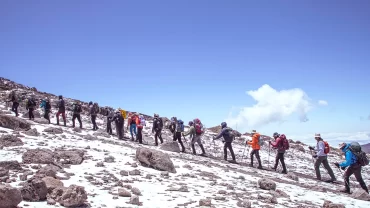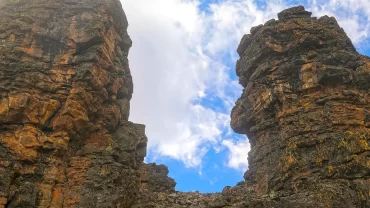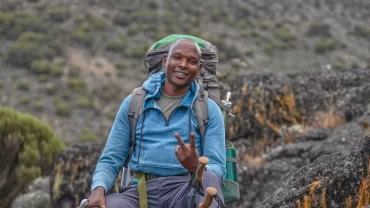Getting Ready to Conquer the Climb
Climbing Mount Kilimanjaro is a life-changing adventure, but reaching the summit requires thorough preparation. Both physical training and mental endurance play a crucial role in your success. This guideline will take you through a step-by-step training plan, essential packing tips, and key insights from Dismass Kilimanjaro Experience (DKE) to help you get ready for this remarkable journey.
1. Physical Preparation for a Kilimanjaro Climb
We recommend a minimum of four months of regular exercise, including cardio, strength training, and altitude preparation. Always consult your physician before beginning a training program to ensure it aligns with your fitness level and health condition.
Month 1: Building a Strong Foundation
Building a strong foundation is crucial for endurance and stamina. Starting with low-impact exercises will help your body adjust to increased activity levels and prevent injuries. Walking, jogging, and cycling are great ways to begin your fitness journey while allowing your muscles to strengthen gradually.
- Begin with light exercises like walking, jogging, or cycling (30 minutes a day).
- Incorporate strength training (lunges, squats, and calf raises) to build endurance.
- Stretching and yoga can improve flexibility and reduce the risk of injury.
- Follow a balanced diet with high-protein meals, whole grains, and plenty of vegetables.
Month 2: Increasing Intensity
Once your body is used to regular movement, it’s time to increase the intensity. At this stage, you should challenge yourself with uphill terrain and more strenuous workouts to improve your cardiovascular capacity.
- Increase workouts to one hour per session, at least three to four times a week.
- Add hill climbs and stair sprints to improve endurance and lung capacity.
- Strength training should include core workouts (planks, sit-ups, and resistance training).
- Maintain hydration and proper nutrition to support muscle recovery.
Month 3: Training Under Load
Simulating the climb experience is essential to ensure you are prepared for Kilimanjaro’s altitude and conditions. Training with a loaded backpack helps your muscles adapt to carrying extra weight, reducing strain on the mountain.
- Increase the distance and elevation of your hikes, simulating Kilimanjaro conditions.
- Train with a loaded backpack (around 15 lbs/7kg) to get used to carrying weight.
- Introduce interval training to build cardiovascular endurance.
Month 4: Fine-Tuning & Recovery
As you approach your trek date, focus on maintaining fitness while allowing time for muscle recovery. Overtraining can lead to exhaustion, so balance your workouts with rest.
- Maintain regular training but allow time for rest and recovery.
- Train with all your gear, including boots, to ensure comfort.
- Do a full gear check to avoid last-minute surprises.
Final Week Before the Climb
- Focus on rest and hydration—avoid intense workouts that could lead to exhaustion or injury.
- Pack and double-check your gear, including well-worn boots.
- If possible, spend time at altitude to acclimate before the climb.
For more details on how climbers overcome Kilimanjaro challenges, check out our article: Inspiring Kilimanjaro Success Stories from Real Climbers.
2. Packing Essentials for Your Kilimanjaro Climb
Packing smart and light is essential for a successful climb. While extra items can be rented in Tanzania, we strongly recommend bringing your own gear to ensure quality and comfort.
Clothing & Layering
Kilimanjaro’s weather can change rapidly, from hot and sunny at the base to freezing temperatures at the summit. Dressing in layers is the best way to regulate body temperature while staying comfortable.
- Base Layers: Moisture-wicking thermal tops and bottoms.
- Insulating Layers: Fleece or down jacket for warmth.
- Outer Shell: Waterproof and windproof jacket and pants.
- Gloves & Hats: Thermal gloves, waterproof gloves, a balaclava, and a warm beanie.
- Gaiters: To keep snow, dust, and debris out of boots.
Footwear
Your choice of footwear is critical to your success on Kilimanjaro. Your boots should provide ankle support, waterproof protection, and durability to handle rough terrain. It is essential to break in your boots well before the climb to avoid blisters and discomfort. In addition to boots, camp shoes are helpful for relaxing after a long day of trekking.
- Hiking Boots: Waterproof, ankle-supportive, and well-broken-in.
- Camp Shoes: Lightweight for evenings at camp.
- Thermal Socks: Wool or synthetic for moisture control.
Gear & Accessories
To stay safe and comfortable on the mountain, having the right accessories is crucial. These items will help with navigation, warmth, and hydration throughout the climb.
- Backpack (Daypack): 25-35L for carrying daily essentials.
- Duffle Bag: 90-120L for porters to carry.
- Trekking Poles: Reduce knee strain and improve balance.
- Sleeping Bag: Rated for -10°C to -20°C.
- Headlamp: Essential for summit night (carry extra batteries).
- Water Bottles & Hydration System: Insulated bottles or CamelBak.
For a complete checklist, download our official guide here: Mount Kilimanjaro Packing Checklist.
3. Plastic-Free Travel & Eco-Friendly Trekking
As an eco-conscious tour company, DKE is committed to minimizing our environmental impact. Tanzania has banned single-use plastic bags since 2019, so we encourage:
- Using cloth or jute bags for packing and separating laundry.
- Bringing a reusable water bottle instead of purchasing plastic bottles.
- Following Leave No Trace principles to keep the mountain clean.
For more on how we support conservation, read How Dismass Kilimanjaro Supports Sustainable Travel.
Final Thoughts
Preparing for Mount Kilimanjaro requires strategic training, smart packing, and eco-conscious planning. By following this guide, you will maximize your chances of reaching the summit of Kilimanjaro while ensuring a safe and rewarding journey.
For more adventure inspiration, check out:
- Life Above the Clouds: What to Expect at Kilimanjaro’s Summit.
- The Best Time to Go on a Safari in Tanzania.
- Combining Adventure and Luxury in Tanzania.
Ready to embark on the ultimate Kilimanjaro adventure? Start preparing today with Dismass Kilimanjaro Experience!





Comment (0)